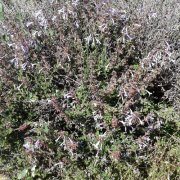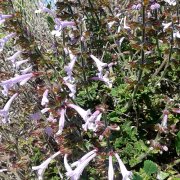Care of the plant Salvia scabra or Coast blue sage |
|
The genus Salvia, family Lamiaceae, comprises 1,000 species of shrubs and herbaceous plants native to Asia, Africa, the Mediterranean region, and Central and South America. Some species are: Salvia scabra, Salvia nemorosa, Salvia namaensis, Salvia microphylla, Salvia mexicana, Salvia mellifera, Salvia leucantha, Salvia lanceolata, Salvia guaranitica, Salvia greggii, Salvia farinacea, Salvia disermas, Salvia canariensis, Salvia aurea, Salvia apiana, Salvia africana, Salvia splendens, Salvia vaseyi, Salvia leucophylla, Salvia verbenacea, Salvia sclarea, Salvia officinalis, Salvia fruticosa, Salvia elegans, Salvia x sylvestris. Common name: Coast blue sage. This species is native to South Africa. They are perennial plants with upright growth and angular stems that reach 90 cm (2.95 feet) in height when they flower. The foliage consists of rough, lobed, dark green leaves. The interesting and abundant bilabiated flowers are mauve in color. They can bloom from late spring to early fall. Coast blue sage is used in pots, to form borders and flower beds and in rockeries; combines well with plants of the Pelargonium, Diascia and Dimorphotheca genera. Salvia scabra needs full sun exposure to look at its best. It resists occasional frosts down to -5 ºC (23 ºF). Coast blue sage grows in any well-drained soil; it prefers a sandy soil. The transplant is done in early spring as well as the planting, keeping a distance of 50 cm between specimens. Water moderately waiting until the substrate has completely dried. Salvia scabra does not need fertilizers. Prune vigorously in late winter and trim off wilted flower stems. Coast blue sage is resistants plants to the usual pests and diseases. Salvia scabra can be propagated in spring by cuttings or from seeds. |
Images of the plant Salvia scabra or Coast blue sage |
Find plants
Salvia scabra or Coast blue sage | Care and Growing
© 2026 FavThemes

